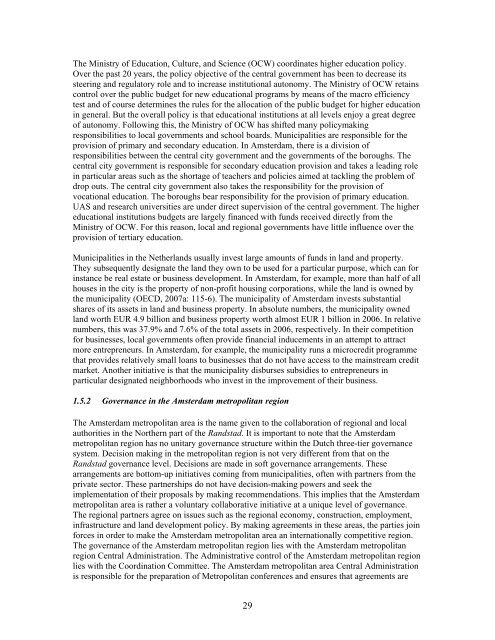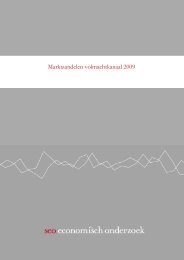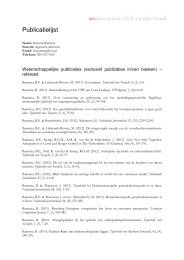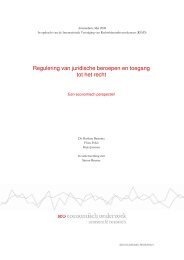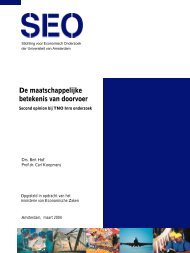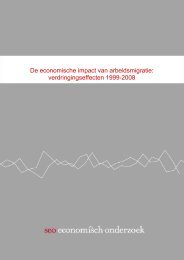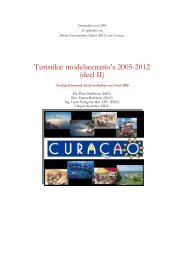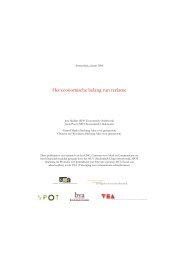The central government is responsible for macro-economic and social-distributional policies. Italso collects the bulk of taxes (taxes on income, profits and capital gains, taxes on property, taxeson goods and services, etc.) and subsequently allocates large amounts of tax revenues to lowerlevelgovernments via targeted funds (called Gemeentefonds for the city communities andProvinciefonds for the provinces).Provinces are responsible for the coordination of a number of public policies, such as planning,transport, culture and social affairs. They also have legal control over the municipalities (notablyin the domain of planning where they approve the municipal land use plan) and over waterboards, and they maintain some operating responsibilities for a few policy sectors like themanagement of the road system. In addition, the provinces correspond with the territorial level ofdeconcentration of some ministries such as those for administering public works, watermanagement and agriculture (OECD, 2007: 159).Municipalities are responsible for a wide range of policy sectors like roads, public transport,housing, local planning, environment, social affairs, economic development, education, healthcare, etc. The municipalities share many of their responsibilities with the central government, butthey are relatively independent. The central government establishes the general framework, rulesand norms that local authorities must follow, monitors most policies’ implementation andcontrols the funding for most policy sectors (OECD, 2007: 159-60). Despite their broadresponsibilities, Dutch municipalities have limited opportunities to impose local taxes. Arelatively small proportion of municipal revenues are raised by local taxes. In 2006, about 5% oftotal tax revenues were levied at the local level. After part of the municipal property tax wasabolished in 2006, however, the proportion of taxes levied at the local level has currently declinedbelow 1% (OECD, 2007).Like most municipalities in the <strong>Netherlands</strong>, <strong>Amsterdam</strong> is run by a city council, governed by amayor, aldermen, and the municipal council. However, unlike most other Dutch municipalities,<strong>Amsterdam</strong> is subdivided into fifteen boroughs (stadsdelen), a system that was implemented inthe 1980s to improve local governance. The boroughs are responsible for many activities that hadpreviously been run by the central city. Fourteen of these have their own council, chosen by apopular election. The fifteenth, Westpoort, covers the harbor of <strong>Amsterdam</strong> and therefore hasvery few residents. For this reason, Westpoort is governed by the central municipal council. Localdecisions are made at borough level, and only affairs pertaining to the whole city, such as majorinfrastructure projects, are handled by the central city council.With respect to regional economic policy, the central government’s policy is aimed at enablingeach region to provide the same level of public goods and services. This takes place via generaland specific grants that are allocated to both provincial and (principally) to municipalgovernments. They are calculated according to criteria that try to take factors into account tocompensate for regional cost differences and differences in revenue raising capacity. Centralstandards and limited local fiscal autonomy ensure that regional differences remain small.Policies promoting regional development are limited (OECD, 2007a: 121-2). With the publicationof the 2004 report Pieken in de Delta by the Ministry of Economic Affairs, regional economicpolicy in the <strong>Netherlands</strong> has shifted towards a focus on strengthening economic key regions,such as the North and South Wings of the Randstad. The goal is to exploit region-specificopportunities of national significance and to make use of the regional potential to create aninternationally competitive investment climate. In the North Wing of the Randstad, whichincorporates the <strong>Amsterdam</strong> metropolitan area, a number of sectors have been selected that aresupported: creative industry, innovative logistics, trade, tourism, and life sciences and the medicalcluster. Within these clusters projects were selected in 2006. Over the period 2007-2010 they willreceive EUR 271 million from the Ministry of Economic Affairs (OECD, 2007a: 123).28
The Ministry of Education, Culture, and Science (OCW) coordinates higher education policy.Over the past 20 years, the policy objective of the central government has been to decrease itssteering and regulatory role and to increase institutional autonomy. The Ministry of OCW retainscontrol over the public budget for new educational programs by means of the macro efficiencytest and of course determines the rules for the allocation of the public budget for higher educationin general. But the overall policy is that educational institutions at all levels enjoy a great degreeof autonomy. Following this, the Ministry of OCW has shifted many policymakingresponsibilities to local governments and school boards. Municipalities are responsible for theprovision of primary and secondary education. In <strong>Amsterdam</strong>, there is a division ofresponsibilities between the central city government and the governments of the boroughs. Thecentral city government is responsible for secondary education provision and takes a leading rolein particular areas such as the shortage of teachers and policies aimed at tackling the problem ofdrop outs. The central city government also takes the responsibility for the provision ofvocational education. The boroughs bear responsibility for the provision of primary education.UAS and research universities are under direct supervision of the central government. The highereducational institutions budgets are largely financed with funds received directly from theMinistry of OCW. For this reason, local and regional governments have little influence over theprovision of tertiary education.Municipalities in the <strong>Netherlands</strong> usually invest large amounts of funds in land and property.They subsequently designate the land they own to be used for a particular purpose, which can forinstance be real estate or business development. In <strong>Amsterdam</strong>, for example, more than half of allhouses in the city is the property of non-profit housing corporations, while the land is owned bythe municipality (OECD, 2007a: 115-6). The municipality of <strong>Amsterdam</strong> invests substantialshares of its assets in land and business property. In absolute numbers, the municipality ownedland worth EUR 4.9 billion and business property worth almost EUR 1 billion in 2006. In relativenumbers, this was 37.9% and 7.6% of the total assets in 2006, respectively. In their competitionfor businesses, local governments often provide financial inducements in an attempt to attractmore entrepreneurs. In <strong>Amsterdam</strong>, for example, the municipality runs a microcredit programmethat provides relatively small loans to businesses that do not have access to the mainstream creditmarket. Another initiative is that the municipality disburses subsidies to entrepreneurs inparticular designated neighborhoods who invest in the improvement of their business.1.5.2 Governance in the <strong>Amsterdam</strong> metropolitan regionThe <strong>Amsterdam</strong> metropolitan area is the name given to the collaboration of regional and localauthorities in the Northern part of the Randstad. It is important to note that the <strong>Amsterdam</strong>metropolitan region has no unitary governance structure within the Dutch three-tier governancesystem. Decision making in the metropolitan region is not very different from that on theRandstad governance level. Decisions are made in soft governance arrangements. Thesearrangements are bottom-up initiatives coming from municipalities, often with partners from theprivate sector. These partnerships do not have decision-making powers and seek theimplementation of their proposals by making recommendations. This implies that the <strong>Amsterdam</strong>metropolitan area is rather a voluntary collaborative initiative at a unique level of governance.The regional partners agree on issues such as the regional economy, construction, employment,infrastructure and land development policy. By making agreements in these areas, the parties joinforces in order to make the <strong>Amsterdam</strong> metropolitan area an internationally competitive region.The governance of the <strong>Amsterdam</strong> metropolitan region lies with the <strong>Amsterdam</strong> metropolitanregion Central Administration. The Administrative control of the <strong>Amsterdam</strong> metropolitan regionlies with the Coordination Committee. The <strong>Amsterdam</strong> metropolitan area Central Administrationis responsible for the preparation of Metropolitan conferences and ensures that agreements are29
- Page 1 and 2: Please cite this paper as:SEO Econo
- Page 6 and 7: 2.3 Higher education and the labor
- Page 8 and 9: 6.3 Mechanisms to promote regional
- Page 10 and 11: Table 4-4: Completion rates of diff
- Page 12 and 13: LSCA Life Sciences Center Amsterdam
- Page 14 and 15: such as regional authorities and th
- Page 17 and 18: 1. OVERVIEW OF THE REGION1.1 Introd
- Page 19 and 20: the southEastern part of Amsterdam
- Page 21 and 22: elatively bad accessibility of the
- Page 23 and 24: metropolitan area exceeded that of
- Page 25: egion suffer from one of the follow
- Page 28 and 29: Figure 1-7: Dropouts secondary educ
- Page 30 and 31: Figure 1-9: Employment in Amsterdam
- Page 32 and 33: high-tech sectors is relatively hig
- Page 34 and 35: 1.4.4 Labor market indicatorsTable
- Page 38 and 39: implemented. There is also an admin
- Page 41 and 42: 2 CHARACTERISTICS OF THE HIGHER EDU
- Page 43 and 44: Source: MinOCW (2007a: 68), EU (199
- Page 45 and 46: (ibid: 83). In part, this new syste
- Page 47 and 48: Table 2-1: Student enrolment at UAS
- Page 49 and 50: Figure 2-5: Students at universitie
- Page 51 and 52: Figure 2-6: Participation in tertia
- Page 53 and 54: also show a continued high demand f
- Page 55 and 56: not receive funding from the govern
- Page 57 and 58: of diplomas awarded and the number
- Page 59: decision is up to the HEI itself. I
- Page 62 and 63: Figure 3-1: Components of an innova
- Page 64 and 65: 3.2.3 National funding frameworkThe
- Page 66 and 67: challenge for the years to come wil
- Page 68 and 69: Figure 3-3: R&D expenditures in Noo
- Page 70 and 71: Amsterdam Topstad programme.Creativ
- Page 72 and 73: 3.5.3 Life SciencesGiven the high l
- Page 74 and 75: Figure 3-4: Employment in Amsterdam
- Page 76 and 77: years. Employment in the trade and
- Page 78 and 79: employment has no upward or downwar
- Page 80 and 81: and more efficient exploitation of
- Page 82 and 83: mostly happens in the context of R&
- Page 84 and 85: income related to IP rights. The fa
- Page 86 and 87:
Figure 3-6: Regional innovation sys
- Page 88 and 89:
HEIs to play this role, as it draws
- Page 91 and 92:
4 CONTRIBUTION OF TEACHING & LEARNI
- Page 93 and 94:
housing market, on the ‘buying ma
- Page 95 and 96:
transport, finance, financial manag
- Page 97 and 98:
HvA participates in several initiat
- Page 99 and 100:
4.4 Student recruitment and regiona
- Page 101 and 102:
4.4.1.2 Recruitment of foreign stud
- Page 103 and 104:
• HvA has made its educational pr
- Page 105 and 106:
The HEIs have several external and
- Page 107 and 108:
Table 4-4: Completion rates of diff
- Page 109 and 110:
4.7 Enhancing the regional learning
- Page 111 and 112:
4.8 ConclusionTable 4-6: SWOTStreng
- Page 113:
Amsterdam is matched by a relative
- Page 116 and 117:
The challenge for future social pol
- Page 118 and 119:
The VU likewise develops research p
- Page 120 and 121:
directing, documentary directing, s
- Page 122 and 123:
the university to improve its energ
- Page 125 and 126:
6.1 Introduction6 CAPACITY BUILDING
- Page 127 and 128:
Figure 6-1: Organization chart Vrij
- Page 129 and 130:
There are also examples of more spe
- Page 131 and 132:
Box 6-2: Obstacles for collaboratio
- Page 133 and 134:
eyond labor market studies, there a
- Page 135 and 136:
7 CONCLUSIONS: MOVING BEYOND THE SE
- Page 137 and 138:
…requires different forms of coop
- Page 139 and 140:
at higher levels in order to mainta
- Page 141 and 142:
to increase the interaction between
- Page 143 and 144:
mobility in the world is slackening
- Page 145 and 146:
ecause they are better informed abo
- Page 147 and 148:
REFERENCESAalders, R., A. Bakkeren,
- Page 149 and 150:
EZ Amsterdam (2006), “Research Bu
- Page 151 and 152:
MinOCW (2007a), “The Education Sy
- Page 153 and 154:
SER (2008), “Duurzame Globaliseri
- Page 155:
Versleijen, A., van der Meulen, B.,
- Page 158 and 159:
Institution City Type ofHEIANNEX B:
- Page 160 and 161:
Groningenculture)Hogeschool Amsterd
- Page 163 and 164:
ANNEX C: KEY ECONOMIC INDICATORSTab
- Page 165 and 166:
ANNEX E: REGIONAL PARTNERSHIPS OF A
- Page 167 and 168:
AmsterdamUniversity CollegeOther re
- Page 169 and 170:
ANNEX F: BUSINESSES REPRESENTED IN
- Page 171 and 172:
GLOSSARYBologna DeclarationForeign


